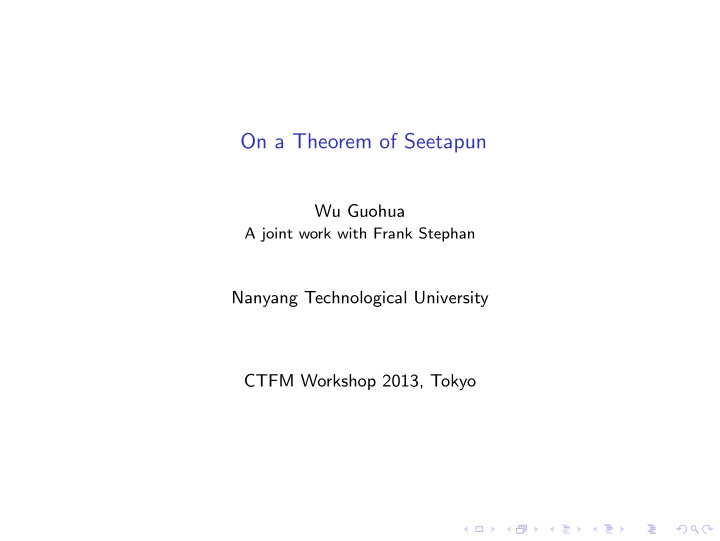



On a Theorem of Seetapun Wu Guohua A joint work with Frank Stephan Nanyang Technological University CTFM Workshop 2013, Tokyo
Post’s problem A Turing degree is c.e. if it contains a c.e. set. The c.e. degrees form an upper-semi lattice with greatest and least elements, 0 ′ and 0 . Post: Are there any other c.e. degrees? Post’s efforts: ◮ simple sets, ◮ hypersimple sets, ◮ hyperhypersimple sets.
Friedberg-Muchnik Theorem The answer to Post problem is “YES”. 0 ′ r r r r 0 Significance: a technique, called “priority injury argument”, was invented.
Sacks’ Two Theorems ◮ Sacks Splitting Theorem: Every nonzero c.e. degree is the join of two incomparable c.e. degrees. ◮ Sacks Density Theorem: The c.e. degrees are dense. New features of Sacks’ theorems: complexity of injury arguments Shoenfield conjectured that the structure of c.e. degrees is not complicated.
Shoenfield Conjecture Shoenfield Conjecture As an upper-semi lattice, the structure of c.e. degrees is countably categorical. ◮ If the conjecture is true, the theory of this countable structure is decidable. ◮ Lachlan and Yates first proved the existence of minimal pairs and hence Shoenfield Conjecture is wrong.
Minimal pairs, cappable degrees, noncapable degrees 0 ′ r r r ❏ ✡ ❏ ✡ ❏ ✡ ❏ ✡ ❏ ✡ ❏ ✡ r 0
High/Low hierarchy ◮ Jump operator - A ′ = { e : Φ A e ( e ) converges } . 0 ′ r high high 2 high 3 low 3 low 2 low r 0
A decomposition of c.e. degrees Theorem Harrington’s Work ◮ Caps or Cups ◮ Caps and Cups
A decomposition of c.e. degrees Theorem Harrington’s Work ◮ Caps or Cups ◮ Caps and Cups Theorem AJSS’s decomposition Theorem ◮ All cappable degrees form an ideal of c.e. degrees; ◮ All noncappable degrees form a strong filter of c.e. degrees; ◮ A c.e. degree is noncappable if and only if it is low-cuppable;
Cuppable degrees Theorem Recent Work ◮ There is a low 2 , but not low-cuppable, degree. (LWZ)
Cuppable degrees Theorem Recent Work ◮ There is a low 2 , but not low-cuppable, degree. (LWZ) ◮ There exists a cuppable degree, which is only high-cuppable to 0 ′ . (GNW)
Cuppable degrees Theorem Recent Work ◮ There is a low 2 , but not low-cuppable, degree. (LWZ) ◮ There exists a cuppable degree, which is only high-cuppable to 0 ′ . (GNW) ◮ There exists two cuppable degrees such that no incomplete c.e. degree can cup both to 0 ′ simultaneously. This implies that the quotient structure R / NCup contains a minimal pair. (LWY)
Locally noncappable degrees Definition: (Seetapun) A nonzero c.e. degree a is locally noncappable if there is a c.e. degree c above a such that no nonzero c.e. degree below c can form a minimal pair with a . We say that c witnesses that a is locally noncappable. Theorem: Downey, Stob Any nonzero c.e. degree a bounds a nonzero c.e. degree c such that c is noncappable below a .
Theorem: (Seetapun, 1991) Each nonzero incomplete c.e. degree a is locally noncappable.
Theorem: (Seetapun, 1991) Each nonzero incomplete c.e. degree a is locally noncappable. As a corollary, there is no maximal nonbounding degree, as when a is a nonbounding degrees, so is c .
Theorem: (Seetapun, 1991) Each nonzero incomplete c.e. degree a is locally noncappable. As a corollary, there is no maximal nonbounding degree, as when a is a nonbounding degrees, so is c . Mathew Giorgi published Seetapun’s result in 2004.
Theorem: (Seetapun, 1991) Each nonzero incomplete c.e. degree a is locally noncappable. As a corollary, there is no maximal nonbounding degree, as when a is a nonbounding degrees, so is c . Mathew Giorgi published Seetapun’s result in 2004. Theorem: (Stephan and Wu) The witness c can be high 2 .
Our construction involves new features: ◮ It is a gap-cogap argument, where a cogap can be open again and this can happen infinitely many often, corresponding to a divergence outcome. ◮ Two actions can reopen a cogap.
Our construction involves new features: ◮ It is a gap-cogap argument, where a cogap can be open again and this can happen infinitely many often, corresponding to a divergence outcome. ◮ Two actions can reopen a cogap. The following are direct corollaries: ◮ Continuity of capping (Harrington and Soare, 1989) ◮ There is a high 2 nonbounding degree [Downey, Lempp and Shore, 1993].
Our construction involves new features: ◮ It is a gap-cogap argument, where a cogap can be open again and this can happen infinitely many often, corresponding to a divergence outcome. ◮ Two actions can reopen a cogap. The following are direct corollaries: ◮ Continuity of capping (Harrington and Soare, 1989) ◮ There is a high 2 nonbounding degree [Downey, Lempp and Shore, 1993]. ◮ There is a high 2 plus-cupping degree, in terms of Harrington [Li, 2010].
Our construction involves new features: ◮ It is a gap-cogap argument, where a cogap can be open again and this can happen infinitely many often, corresponding to a divergence outcome. ◮ Two actions can reopen a cogap. The following are direct corollaries: ◮ Continuity of capping (Harrington and Soare, 1989) ◮ There is a high 2 nonbounding degree [Downey, Lempp and Shore, 1993]. ◮ There is a high 2 plus-cupping degree, in terms of Harrington [Li, 2010]. ◮ There is a high 2 degree bounding no bases of Slaman triples [Leonardi, 1996].
High permitting High c.e. degrees behave like 0 ′ .
High permitting High c.e. degrees behave like 0 ′ . Every high c.e. degree bounds ◮ a minimal pair (Cooper, 1973); ◮ a high noncuppable degree (Harrington, around 1973); ◮ a Slaman triple (Shore and Slaman, 1993).
Thanks!
Recommend
More recommend